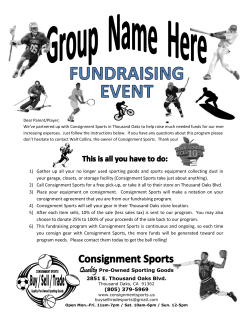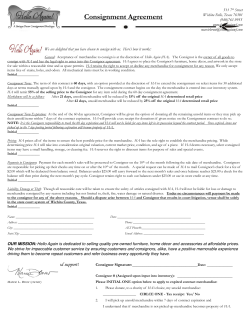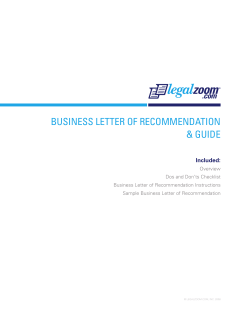
CONSIGNMENT AGREEMENT & GUIDE Included: Overview
CONSIGNMENT AGREEMENT & GUIDE Included: Overview Dos and Don’ts Checklist Consignment Agreement Instructions Sample Consignment Agreement © LEGALZOOM.COM, INC. 2008 1. Overview Businesses choose consignment arrangements for many reasons. Retail stores may want to test marketplace demand for a new product. Those stores can sell goods on consignment without investing initial capital in purchasing them outright: the store will remit payment only when the consigned items are sold. A confident manufacturer (or artist or other “creator”) may be willing to take that risk, secure that its goods will sell themselves. It can shore up that risk as well, requiring in its consignment agreement that the retail store invest significant marketing dollars in promoting the goods. Although a consignment arrangement may be profitable for both retailer and creator in the long run, it is essential that at the outset each party sign and maintain paperwork sufficient to protect and satisfy its individual interests. A well-drafted consignment agreement must provide for some form of inventory control and a clear allocation of the rights and responsibilities of each party. This package contains everything you’ll need to customize and complete your consignment agreement. A written agreement minimizes confusion, misunderstanding, and error, and clearly sets forth the parties’ expectations and fulfillment obligations. Once signed, each party will be able to focus on its area of expertise: the retailer on selling and the manufacturer on creating. In every way, this promotes a successful division of labor and a profitable long-term business arrangement. 2. Dos & Don’ts Checklist Have an in-depth discussion about the products to be consigned. What makes them unique? What makes them attractive to purchasers? Who is the audience for these products? The more information the parties share, the greater the opportunities for marketing and sales. Before writing your agreement, decide what your goals are. A good legal contract is one that captures the intentions of the parties accurately. Take a moment to clarify the terms and conditions of the agreement before memorializing them in written form. If any provision of your agreement is confusing, try to make it clearer. A few hours spent improving your agreement now could prevent weeks of future headaches. Allow each party to spend some time reviewing the agreement. This will reduce the likelihood, or at least the efficacy, of a claim that a party did not understand the agreement’s terms. Both parties should review the assignment carefully to ensure that all relevant deal points have been included. It is better to be over-inclusive than under-inclusive. Do not assume that certain expectations or terms are agreed to if they are not stated expressly on the document. A contract should be signed before any services are performed, goods are exchanged, or money is transferred. Sign two copies of the agreement, one for you and one for the other party. Depending on the nature of its terms, you may decide to have your agreement witnessed or notarized. This will limit later challenges to the validity of a party’s signature. CONSIGNMENT AGREEMENT © LEGALZOOM.COM, INC. 2008 1 Careful record-keeping is essential to the consignment relationship. The manufacturer or creator should prepare and present an inventory sheet with each delivery and keep this sheet up to date with payment summaries and count totals. Good recordkeeping can limit later disagreements or lawsuits. If your deal or agreement is complicated, do not use this agreement. Contact an attorney to help you draft a contract that will meet your specific needs. 3. Consignment Agreement Instructions The following provision-by-provision instructions will help you understand the terms of your consignment agreement. The numbers below (e.g., Section 1, Section 2, etc.) correspond to provisions in the agreement. Please review the entire document before starting your step-by-step process. • Introduction of Parties. Identifies the parties and the date of the agreement. The party that is providing the property is called the “Consignor.” The party that is selling the property is called the “Consignee.” These names are used throughout the agreement. • Recitals. Explains why the parties are entering their agreement. Describe the general retail purpose of the Consignee in the blank space provided (e.g., “The Consignee is engaged in the retail sale of automobiles and automobile parts.”). • Section 1: Consigned Property. Describes the property that will be sold by the Consignee on behalf of the Consignor, and how many units of each item will be provided. Use as much detail as possible, including (if available) factory codes, serial numbers, model and style numbers, etc. You and the other party should also agree on an initial retail price for each listed item and the date on which those goods will be delivered. • Section 2: Delivery of Goods. States that the property is being provided on a consignment basis only, and explains that the Consignor bears both the cost of delivering the products and the risk of any loss or damage occurring during that transport. • Section 3: Consignment Period. Provides that the initial length of the consignment period is one month. This period automatically extends from month-to-month afterwards, unless either party ends it. You and the other party can enter a maximum amount of time a consignment period can be extended. • Section 4: Efforts to Sell. It’s one thing for a retailer to allow items to sit in its store. It’s another for that retailer to promote the sale of those items by giving them proper positioning and attention. This section provides that the Consignee’s obligations go beyond simply keeping the products in its store: it must also make reasonable efforts to sell the property at the price agreed to in Section 1. CONSIGNMENT AGREEMENT © LEGALZOOM.COM, INC. 2008 2 • Section 5: Title to Products. A consignment arrangement is different than most relationships between manufacturers and stores selling on their behalf. In the usual case, property ownership is transferred to the store when the property is received: they have paid to purchase that property and the property is part of the company’s assets. By contrast, the property transferred in a consignment agreement is still owned by the manufacturer, even though it is in the hands of the store. This paragraph emphasizes again that the parties to the agreement are entering into a consignment arrangement. • Section 6: Payment; Commission. You and the other party can use the blanks here to indicate what percentage of the sale will be kept by the Consignee as a “fee” for its services. You can also determine whether the Consignee has to remit the remaining proceeds within a certain number of days, or whether monthly payments would be preferable for your arrangement. • Section 7: Risk of Loss; Damage. Requires the Consignor to maintain and protect the products while they are in its possession. If any property is damaged during that time, the Consignor must reimburse the Consignee for that loss. • Section 8: Return of Products. This allows the Consignor to request a return of its products on the provision of some reasonable notice. The parties can determine how long this period should be. In addition, after the end of the consignment term, the Consignee can demand that the Consignor retrieve its products. You and the other party can determine that time frame as well. • [Optional] Section 9: Additional Terms. This is an optional provision that can include any additional terms that have not already been listed. For example, if the parties will exchange confidential information, you may want to include a provision governing the protection of that information. Alternatively, you and the other party may want to provide that if and when products are sold, replacement products will be provided to the Consignee by the Consignor within a certain amount of time. If you remove this section, correct the section numbers and references in the agreement. • Section 10: Termination. Explains that either party can end the agreement at any time for any reason. If the parties do decide to end the agreement, this paragraph indicates when and how any unsold products should be returned. Enter in the amount of time the Consignee has to return the property after the agreement ends. • Section 11: No Assignment. States that neither party can transfer its obligations under the agreement without the prior written consent of the other party. • Section 12: Notices. Lists the addresses to which all official or legal correspondence will be delivered. • [Optional] Section 13: Default. An optional provision that can be used to provide additional security to the Consignor. Essentially, this section indicates that if the Consignor requests that the Consignee file papers swearing officially that the products are owned by the Consignor, the Consignee is obligated to do so. If you remove this section, correct the section numbers and references in the agreement. • Section 14: No Product Warranties. Indicates that there are no warranties on the consigned products, except to the extent required by law. CONSIGNMENT AGREEMENT © LEGALZOOM.COM, INC. 2008 3 • [Optional] Section 15: Consignor’s Representations, Warranties, and Indemnification. An optional provision indicating that the Consignor owns the property and that no other person or company has an interest in the property. Also states that Consignor will be responsible for the cost of defending this title. If you remove this section, correct the section numbers and references in the agreement. • Section 16: Governing Law and Equitable Relief. Allows the parties to choose the state and county laws that will be used to interpret the agreement. Note that this is not a venue provision: the included language will not impact where a potential claim can be brought. Please write the applicable state and county in the blanks provided. The provision also allows the parties to seek equitable relief (i.e., court remedies requiring a party to perform or refrain from performing certain acts) for any violation of the agreement. • Section 17: Entire Agreement. The parties’ agreement that the document they’re signing is “the agreement” about the issues involved. In other words, if previous agreements or promises surface, the signed agreement will control. Unfortunately, the inclusion of this provision will not prevent a party from arguing that other enforceable promises exist, but it will provide you some protection from these claims. • Section 18: No Implied Waiver. Explains that if either party ignores or allows the other to break an obligation under the agreement, it does not mean that party waives its future rights to enforce the same (or other) obligations. • Section 19: Severability. Protects the terms of the agreement as a whole, even if one part is later invalidated. For example, if a state law is passed prohibiting choice-of-law clauses, it will not undo the entire agreement. Instead, only the section dealing with choice of law would be invalidated, leaving the remainder of the agreement enforceable. • Section 20: Counterparts/Electronic Signatures. The title of this provision sounds complicated, but it is simple to explain. It says that even if the parties sign the agreement in different locations, or use electronic devices to transmit signatures (e.g., fax machines or computers), all of the separate pieces will be considered part of the same agreement. In a modern world where signing parties are often not in the same city - much less the same room - this provision ensures that business can be transacted efficiently, without sacrificing the validity of the agreement as a whole. • Section 21: Headings. Notes that the headings at the beginning of each section are meant to organize the document, and should not be considered operational parts of the agreement. DISCLAIMER LegalZoom is not a law firm. The information contained in the packet is general legal information and should not be construed as legal advice to be applied to any specific factual situation. The use of the materials in this packet does not create or constitute an attorney-client relationship between the user of this form and LegalZoom, its employees or any other person associated with LegalZoom. Because the law differs in each legal jurisdiction and may be interpreted or applied differently depending on your location or situation, you should not rely upon the materials provided in this packet without first consulting an attorney with respect to your specific situation. The materials in this packet are provided "As-Is," without warranty or condition of any kind whatsoever. LegalZoom does not warrant the materials' quality, accuracy, timeliness, completeness, merchantability or fitness for use or purpose. To the maximum extent provided by law, LegalZoom, it agents and officers shall not be liable for any damages whatsoever (including compensatory, special, direct, incidental, indirect, consequential, punitive or any other damages) arising out of the use or the inability to use the materials provided in this packet. CONSIGNMENT AGREEMENT © LEGALZOOM.COM, INC. 2008 4 Form Sample CONSIGNMENT AGREEMENT © LEGALZOOM.COM, INC. 2008 5
© Copyright 2025





















